Catholic Customs
 |
 |
 |
 |
 |
 |
 |
Counting down the Weeks of Lent
with Effigies
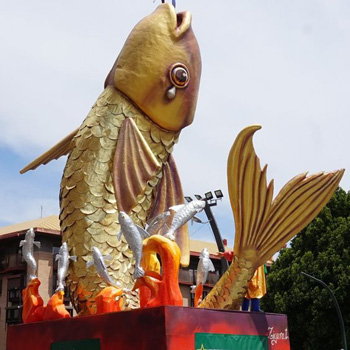
A huge sardine effigy set up to be burned in Murcia, Spain, at Lent's end
The 'Old Woman' effigies of Spain & Italy
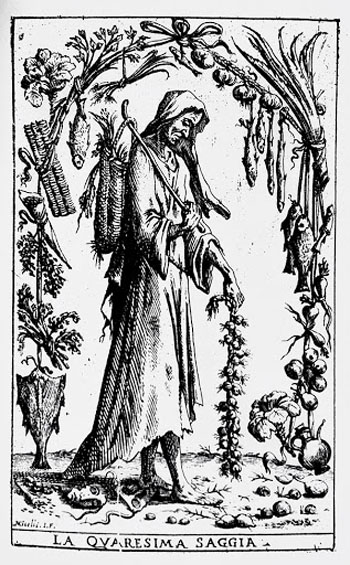
The ‘wise old woman’ with her distaff; below, La Quaresima: a feather is plucked each week of Lent
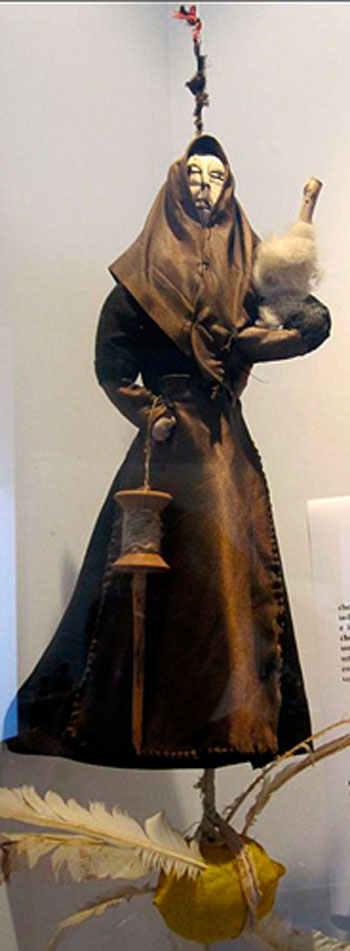
This rejoicing at the end of Lent was not just over the conclusion of the strict fasting and penance that used to be the common practice of Catholics, but more to rejoice in the Resurrection of Our Lord, symbolizing His triumph over death and man's Redemption. (1)
The Italians' Lenten effigy was called "La Quaresima Saggia" ("the wise woman of Lent"), which was hung in a window, on a chimney or balcony, or from a rope stretching across a street on Ash Wednesday.
This effigy was a rag doll dressed in a black dress and a white headdress; she carried a spindle and distaff filled with flax. The thread that ran from distaff to spindle was meant to represent the 40 days of penance.
The small doll stood on an orange, lemon or potato. The piece of fruit or vegetable had seven feathers pierced in it representing the seven weeks of Lent. A hoop made of willow bark hung below the orange carrying symbols of the various foodstuffs permitted during Lent along with one small bottle of wine and one small bottle of spirits.
In some places, the doll had seven feet instead of the feathers. In Sardinia, this seven-footed woman was made out of bread.
During Lent every Saturday or Sunday – depending on the region – the villagers gathered around their "Quaresima" and joyously pluck one feather from the orange indicating that there was one less week to the rigorous Lenten fast.
In some areas, "La Quaresima" was burned or sawed in half at Mid-Lent. If she was sawed in half, she was filled with dried fruits that burst out of her severed body as a special treat for the people in their fasting.
In other Italian regions, "La Quaresima" was placed on a pyre with gunpowder and lighted to produce a dramatic pyrotechnic scene on Holy Saturday. Meat was still not permitted, but cakes and confectionery were eaten as a precursor to the joyous feast that was nigh. (2)
In Calabria, the last feather was plucked on Easter Sunday when the bells returned along with the sweets. As the old Calabrian proverb says, "Glory ringing, sweets are eaten."
In the Calabrian dialect, the old woman was called Corajisima and tales were told that at the stroke of midnight on Shrove Tuesday, Corajisima wandered the streets preparing kettles of boiling water to burn the throat of anyone who would dare to eat meat and violate the Lenten rule. This fearsome legend convinced both young and old to maintain the Lenten fast.
In the town of Palmi, the children sang at play these lines about Corajisima:
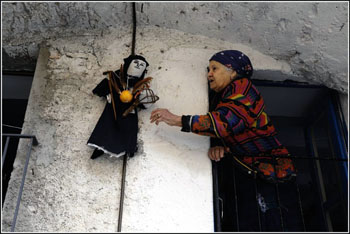
An Calabrian woman prepares to remove one of the feathers from the Corajisima
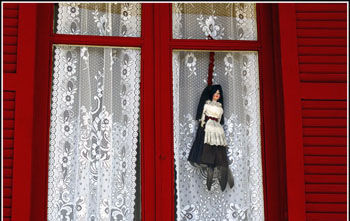
When she falls she breaks her nose;
She hides it in a hole;
Corajisima with the spindle. (3)
The Greeks had a figure of a nun with no mouth called Kyra Sarakosti to represent Lent who was hung on the wall of every home. The mouthless nun represented the Lenten fast. Her hands were crossed over her bosom as in prayer to emphasize the call to prayer; her seven feet symbolized the seven weeks of Lent. Every week one of her feet would be torn off. This custom also existed in some areas of France and Spain.
The people from the Pontus provinces used a potato or onion with seven feathers stuck in it to make their "Kukaras," their Lenten effigy. Each week a feather was plucked from the Kukaras and the grotesque sight of this figure hanging from a ceiling often was threatening enough to prevent children from misbehaving when parents mentioned its name. (4)
Jack-a-Lent
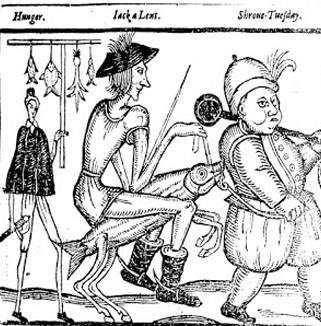
Personifications of Hunger, Jack of Lent &
Shrove Tuesday, respectively
The villagers shot arrows or threw things at the "Jack-a-Lent" when they passed it in the street, for the effigy also came to symbolize Judas Iscariot. On Palm Sunday or Ash Wednesday "Jack" was burned, for medieval man had a hatred for all betrayal, and especially the betrayal of Our Lord Jesus Christ. The custom of burning an effigy of Judas was a common custom in many countries, and will be addressed in a later article.
A poem written by Elderton, in a ballad, called Lenten Stuff describes the tradition well:
When Jack of Lent comes rustling in,
With the headpiece of a herring,
And saith, Repent you of your sin,
For shame, sirs, leave your swearing:
And to Palm Sunday he doth ride,
With sprats and herrings by his side,
And makes an end of Lententide! (5)
These charming customs were simple ways that helped the Catholic man of the past to remember the spirit of Lent and the change it required in his daily life. Let us ask Our Lady to inspire the faithful once again to enter more fully into this penitential season honoring Her Son's Passion, bringing back the charming customs that kept Lent presently before the eyes of families and villages.
Continued
- William Shepard, Curiosities of popular customs and of rites, ceremonies, observances and miscellaneous antiquities, p. 617
- Ibid., pp. 617-618.
- https://www.calabriatheotheritaly.com/lent-in-italy-calabrian-tradition/
- George A. Megas, Greek Calendar Customs (Athens: B. and M. Rhodis, 1963), p. 76.
- When Jakke a' Lent comes justlynge in,
With the hedpeece of a herynge,
And saythe, repent yowe of yower syn,
For shame, syrs, leve yowre swerynge:
And to Palme Sonday doeth he ryde,
With sprots and herryings by his syde,
And makes an end of Lentontyde!

Posted April 5, 2021
______________________
______________________
 |
 |
 |
 |
 |
 |


